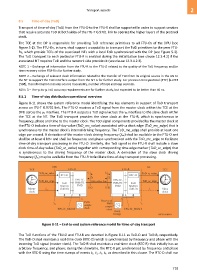Page 729 - 5G Basics - Core Network Aspects
P. 729
Transport aspects 2
8.5 Time-of-day (ToD)
Transport of time-of-day (ToD) from the FTU-O to the FTU-R shall be supported in order to support services
that require accurate ToD at both sides of the ITU-T G.9701 link to operate the higher layers of the protocol
stack.
The TCE at the DP is responsible for providing ToD reference primitives to all FTU-Os of the DPU (see
Figure 5-2). The FTU-Os, in turn, shall support a capability to transport the ToD primitives to the peer FTU-
Rs, which provide TCEs of the associated NTs with a local ToD synchronized with the DP (see Figure 5-3).
The ToD transport to each particular FTU-R is enabled during the initialization (see clause 12.3.4.2) if the
associated NT requires ToD and the network side provides it (see clause 12.3.4.2.3).
NOTE 1 – Exchange of information from the FTU-R to the FTU-O related to the quality of the ToD frequency and/or
time recovery at the FTU-R is for further study.
NOTE 2 – Exchange of relevant clock information related to the transfer of ToD from its original source in the AN to
the NT to support the ToD interface output from the NT is for further study. For precision time protocol (PTP) [b-IEEE
1588], this information includes source traceability, number of hops and leap seconds.
NOTE 3 – The O to R ToD accuracy requirements are for further study, but expected to be better than 50 ns.
8.5.1 Time-of-day distribution operational overview
Figure 8-11 shows the system reference model identifying the key elements in support of ToD transport
across an ITU-T G.9701 link. The FTU-O receives a ToD signal from the master clock within the TCE at the
DPU across the O interface. The FTU-R outputs a ToD signal across the R interface to the slave clock within
the TCE at the NT. The ToD transport provides the slave clock at the FTU-R, which is synchronous in
frequency, phase and time to the master clock. The ToD signal components provided by the master clock at
the FTU-O include a time-of-day value (ToD_mc_value) associated with a clock edge (ToD_mc_edge) that is
synchronous to the master clock's internal driving frequency. The ToD_mc_edge shall provide at least one
edge per second. A derivative of the master clock driving frequency (fmc) shall be available to the FTU-O and
shall be at least 8 kHz and shall be frequency and phase synchronized with the ToD_mc_edge to facilitate
time-of-day transport processing in the FTU-O. Similarly, the ToD signal at the FTU-R shall include a slave
clock time-of-day value (ToD_sc_value) together with corresponding time edge marker (ToD_sc_edge) that
is synchronous to the driving frequency of the master clock. A derivative of the slave clock driving
frequency (fsc) may be available from the FTU-R to facilitate time-of-day transport processing.
Figure 8-11 – End-to-end system reference model for time-of-day transport
The ToD functions of the FTU-O and FTU-R are denoted in Figure 8-11 as ToD-O and ToD-R, respectively.
The ToD-O shall maintain a real-time clock (RTC-O) which is synchronized by frequency and phase with the
incoming ToD signal (master clock). The ToD-R shall maintain a real-time clock (RTC-R) that initially has an
arbitrary frequency, and phase; during the showtime, the RTC-R get synchronized by frequency and phase
with the RTC-O using the time stamps of events t1, t2, t3, t4, as described in this clause. The RTC-O shall run
719

